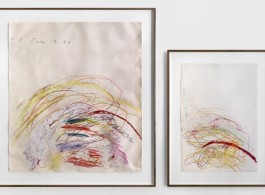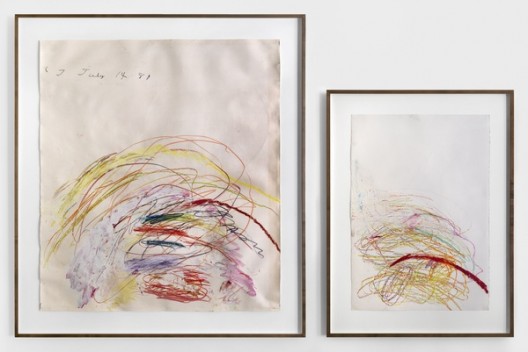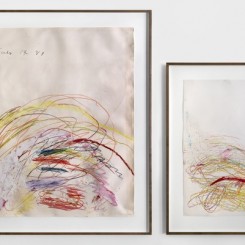Simon Lee
New York
Simon Lee Gallery New York is pleased to present The Tissue of Memory, a cross-generational group exhibition that considers the gesture and its history, as exemplified by the practices of Kelly Akashi, Robert Mangold, Agnes Martin, Win McCarthy, Monique Mouton, Josephine Pryde, Gary Simmons, Cy Twombly, and Heimo Zobernig. Employing signs, forms, and gestures in service of inscription, the works on view demonstrate artists’ thinking through the medium at hand and materials influencing composition.
The exhibition takes as its starting point the recent book-length study Reading Cy Twombly: Poetry in Paint, in which the literary scholar Mary Jacobus posits the work of Cy Twombly as representative of the working-through impulse. ‘Twombly’s [works] can be read as a form of thinking through (not just about) painting,’ she writes. ‘They invoke both the conditions of their own making and the disciplinary formation of art history.’ In its unique fusion of frenetic painterly abstraction with the metaphysical implications inherent to his scrawled text, Untitled (1981-1982) epitomizes Twombly’s unique formal vocabulary, in which the boundaries between painting and writing have been obliterated in favor of a semantic unity of sign and form. Twombly’s marks manifest both the indexical nature of the medium as well as recording the time the mark was made, the latter literalized in Untitled through the central placement of the artist’s date and signature. To elaborate this premise, the exhibition turns to practices that render their means visible, invoking, to follow Jacobus, those conditions of their own making.
While Twombly’s Untitled produces indexicality through drawing, the Los Angeles-based artist Kelly Akashi’s Woven Lens with Apparatus (2018) does so through sculpture, puncturing glass, still malleable, until the gesture hardens into form. Likewise, the New York-based artist Win McCarthy’s Gridlock Person (2018) also exploits the pliability of molten glass, in this instance by constructing a facial cast that destabilizes our comprehension of its creation, even as it leaves behind a tangible, physical imprint. Like Twombly’s dissolution of language into form, McCarthy’s cast becomes less about the individual and more about an abstracted identity. In Josephine Pryde’s ongoing series Hands (‘Für Mich’), she focuses the camera lens onto the points of connection between hands and various objects, with no other body parts in the frame. Rather than exhibiting the product of the gesture, her photographs concentrate on the closeness of the relation, even a fusion, between the hands and what they are holding. Driftwood worked by the sea, gifts to the artist from her galleries, or tablets with their ‘smartness’ all contain memories, evocations and associations to which the hands make the connection through their grasp. If the final notations are a source of meaning for Twombly, then in Pryde’s photographs, it is rather a visual index of interactions between hands and various devices that is in the process of being created. Elsewhere, New York-based artist Monique Mouton approaches the surface as a site where gestures abound. Brush marks gather on paper alongside fingerprints, pencil marks, punctures, or cuts – vestigial traces of the artist’s process. For Mouton, the frame transcends its conventional purpose to become a form of encasement, binding the work it contains to the moment of its making.
As such, The Tissue of Memory identifies the point at which the artist’s material intervention becomes an act of indexical inscription. All the works included in the exhibition are animated by a certain tension between memory and anticipation, between the implied act of mark-making and its record. After Roland Barthes’ description of Twombly’s works-on-paper, these pieces tend to be ‘conjugated in the past tense or in the future, never really in the present…the tense is perpetually uncertain.’ So, too, for the paintings of Robert Mangold and drawings of Agnes Martin, who, in conversation with the curator Lawrence Alloway, said that her work contained ‘neither objects, nor space, nor time, not anything — no forms…’ Rather than advancing these representational qualities, Martin’s mark-making instead functions as a recording of her act of meditative introspection. For Martin, ‘it is not what is seen. It is what is known forever in the mind.’ Of course, what is ‘known forever in the mind’ is memory, and here we present an inventory of means toward making that fallible, internal process legible.



